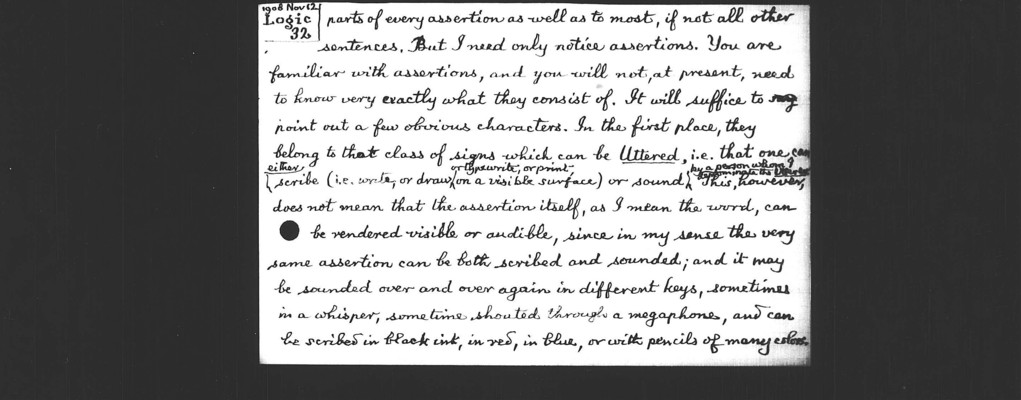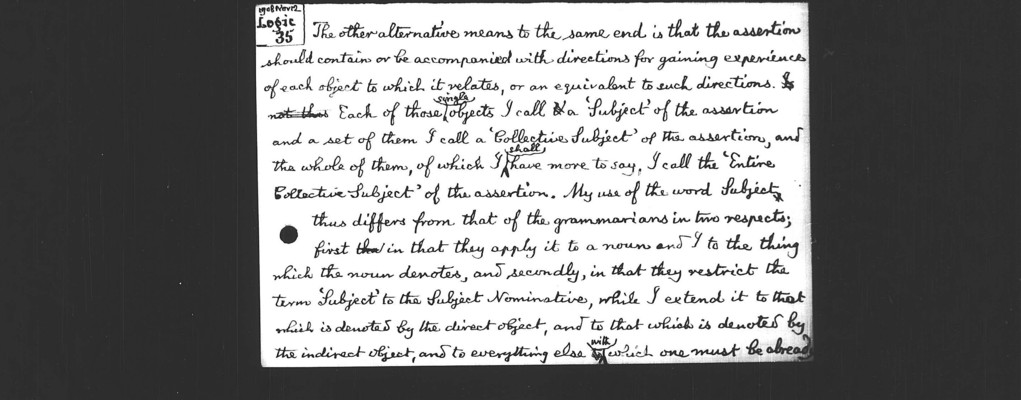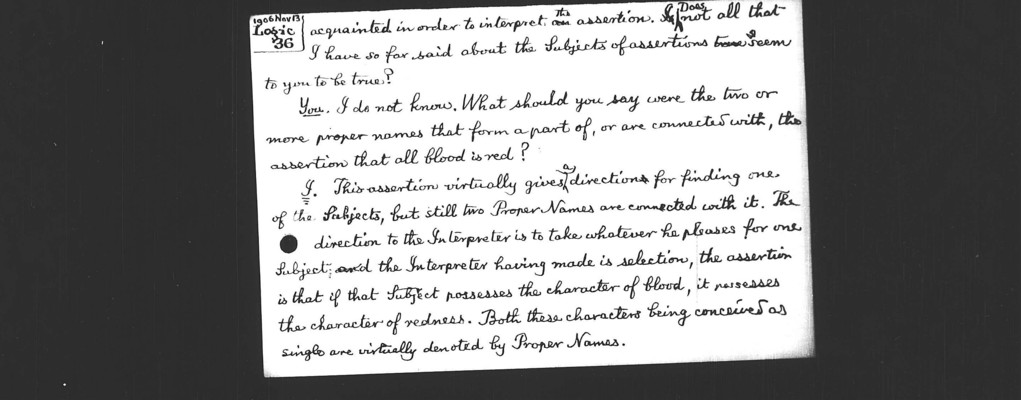Pages
50
1908 Nov 12 Logic 32
parts of every assertion as well as to most, if not all other sentences. But I need only notice assertions. You are familiar with assertions, and you will not, at present, need to know very exatly what they consist of. It will suffice to point out a few obvious characters. In the first place, they belong to that class of signs which can be Uttered, i.e. that one can either scribe (i.e., write, or draw, or typewrite, or print on a visible surface) or sound by a person whom I designate the Utterer. This, however, does not mean that the assertion itself, as I mean the word, can be rendered visible or audible, since in my sense the very same assertion can be both scribed and sounded; and it may be sounded over and over again in different keys, sometimes in a whisper, some time shouted through a megaphone, and can be scribed in black ink, in red, in blue, or with pencils of many color.
51
1906 Nov 12 (??note error on year) Logic 33
It is plain then that what is visible and what is audible are each many different visible and audible objects, or percepts, which are representatives, or as I say, 'Instances,' of the one assertion. I call the person who perceive an Instance of an assertion, and who, in doing so, understands the assertion itself the Interpreter. Now I maintain what you may a first think is a mistake, that in order that the Interpreter may gather to what the assertion relates, or as I phrase it, what its Subjects are one or other of two alternative means must be provided. The first of these means is that the assertion should be provided either as parts of it, or in so close understood relations to it, with(?) as to amount virtually to that, with one or more (almost invariably at least two) Proper Names, or what functions functions as such. By a Proper Name, I mean a name of anything considered as a single thing; and this thing which the Proper Name denominates must have been
52
1908 Nov 12 Logic 34
one with which the interpreter was already acquainted by direct or indirect experience. The process of gaining this experience is one of two, or is some mixture of these. The first of the two is that the Interpreter should first by his own personal experience vecome sufficiently acquainted with that to which the Proper Name applies, and subsequently with the Proper Name as denominating that thing. The second of the two processes is that by overhearing various assertions into which the Proper Name enters, he should discover, first, that it is a Proper Name, and then of what sort of object it is a name, and finally that he should gain a greater or less mass of information about the history of the single object, sufficient to make it stand out in his indirect experience as contrasting with other things of the same sort.
53
1908 Nov 12 Logic 35
The other alternative means to the same end is that the assertion should contain or be accompanied with directions for gaining experiences of each object to which it relates, or an equivalent to such directions. Each of those single objects I call a 'Subject' of the assertion and a set of them I call a 'Collective Subject' of the assertion, and the whole of them, of which I shall have more to say, I call the 'Entire Collective Subject' of the assertion. My use of the word Subject, thus differs from that of the grammarians in two respects; first in that they apply it to a noun and I to the thing which the noun denotes, and secondly, in that they restrict the term 'Subject' to the Subject Nominative, which I extend it to that which is denoted by the direct object, and to that which is denoted by the indirect object, and to everything else with which one must be already
54
1906 Nov 13 Logic 36
acquainted in order to interpret this assertion. Does not all that I have so far said about the Subjects of assertions seem to you to be true?
You. I do not know. What should you say were the two or more proper names that form a part of , or are connected with, the assertion that all blood is red?
I. This assertion virtually gives a direction for finding one of the Subjects, but still two Proper Names are connected with it. The direction to the Interpreter is to take whatever he pleases for one Subject; the Interpreter having made is selection, the assertion is that if that Subject possesses the character of blood, it possesses the character of redness. Both these characters being conceived as single are virtually denoted by Proper Names.




